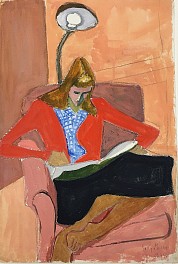BIOGRAPHY

American, 1902-2003
We live in an era of rediscoveries in the arts. One aspect of that is the growing awareness that the work of women artists in the 20th century was marginalized or outright ignored due to sexism both individual and institutional. In the case of Sally Michel, like Elaine De Kooning, she placed her husband Milton Avery's career before her own. As Robert Smith writes in the New York Times:
"Without Sally MIchel there would have been no Milton Avery, or at least not as much."
The fact is that for 40 years Sally Michel painted beside Milton Avery and they discussed art constantly. Together they developed a synthesis of abstraction and realism. Michel built her personal style in an atmosphere of discussion and experimentation with great American abstract artists. She and Milton retained their realist references, but they used unusual perspectives, simplification, and overlapping and non-objective colors to create a modern picture>
Milton Avery and Sally Michel met as young artists during the summer of 1924 painting out of doors in Gloucester, Mass. They were married in 1926. When Milton followed Sally to New York, he had not yet experienced the modernist art out of Europe that was taking New York by storm. Through the late 1920s into the 1940s, Milton Avery and Sally Michel developed their approach to art together.
Michel was interested throughout her life in exploring the effect of color and the flattening of perspective to achieve realist-abstraction. Michel often painted landscapes and figures in flat planes of rich color, where places and people were represented by simple shapes or outlines, without identifying facial features. Her work is characterized by playful color combinations and a depthless blending of background and foreground.
Her husband worked in a very similar style, and the collaboration between husband and wife is apparent in their paintings. Their close working relationship resulted in a coalescence of their aesthetic sensibilities, developing a distinct “Avery style.” Their daughter, March Avery (the subject of this portrait), also became an artist and her parents’ influence is clear in her own work.
Her work can be found in the collections of the Brooklyn Museum, the Corcoran, the Metropolitan Museum of Art, and the Wadsworth Atheneum, among others.
